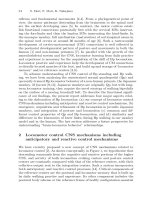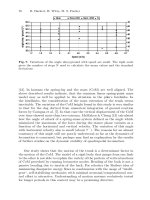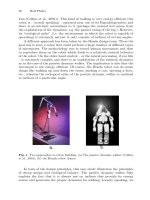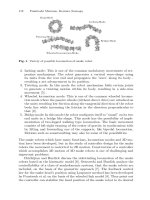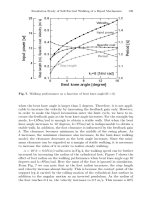Adaptive Motion of Animals and Machines - Hiroshi Kimura et al (Eds) part 15 pdf
Bạn đang xem bản rút gọn của tài liệu. Xem và tải ngay bản đầy đủ của tài liệu tại đây (447.08 KB, 17 trang )
282
A. E. Patla, M. Cinelli, M. Greig
(Drew et al., 1986). The challenge has been on the sensory side, specifically
controlling the visual input, determining the spatial and temporal link and
the transformation between the sensory input and motor output and identifying the many roles visual input plays in controlling locomotion. Psychophysical studies examining perceptual responses to visual inputs (abstraction of
naturally occurring stimuli pattern during locomotion) focus on the sensory
side without examining how the relevant information is used to guide action. Recording of neural activity in animals in response to similar stimuli
or functional neuro-imaging studies in humans while fruitful also do not provide insights into the actual information and strategies used during adaptive
locomotion. In our lab we have manipulated the environment, and/or visual
input and examined the spatial and temporal characteristics of the changes
that occur in the gait patterns.
2
The twelve postulates for visual control of human
locomotion
Based on a series of experiments done in our lab, we have been able to come
up with a set of postulates that provide unique insights into visual control of
human locomotion (Patla, 1997, Patla, 1998; Patla, 2003). These are grouped
under a series of questions that have guided our research.
Q1: What information does vision provide, that is unique and
cannot be easily substituted by other sensory modalities?
P1. Vision provides unique, accurate and precise information at the right
time and location about the environment at a distance (Exteroceptive), information about posture and movements of the body/body segment and information about self-motion (Ex-proprioceptive). For example, environmental
information provided by haptic sense, used so effectively by visually impaired
individuals, is not accurate or precise enough and takes much longer to obtain
the information (see Patla, Davies & Niechweij, 2003).
Q2. Where and when are different types of visual information
used?
P2. Environmental information, both visually observable and visually inferred, is used in a sampled feed-forward control mode to adapt basic walking
patterns by influencing whole body motor patterns.
P3. Postural and movement information about the lower limbs is used in a
sampled on-line control mode to fine-tune the adaptive swing limb trajectory
(Patla et al, 2002).
P4. Self-motion information is used in a sampled on-line control mode to
maintain postural orientation and balance during locomotion.
Q3. How is this visual information acquired?
P5. Combination of whole body, head and eye movements are used to
acquire visual information. The most common gaze pattern during adaptive
locomotion does not involve active gaze transfer to objects of interest: rather
Coupling Environmental Information from Visual System to Changes
283
gaze is anchored in front of the feet and is carried by the moving observer
giving rise to optic flow (Patla, 2003). This has clear implications for the
control of moving image capture in legged robots: as long as the video cameras are stabilized and oriented appropriately relative to the terrain, relevant
information can be extracted from the optic flow.
Fig. 1. Dominant gaze behavior is similar to carrying a torch shining at a fixed
distance on the ground ahead of the person.
Q4. What are the characteristics of the visual-to-motor transformation?
P6. Visual-motor transformation for adaptive locomotion is not just dependent on visual input: prediction of future limb trajectory along with a
priori rules influences the selection of an adaptive strategy.
P7. Proactive adaptive gait strategies involve global modifications to movement patterns and exploit inter-segmental dynamics to provide simple and
efficient control.
P8. The duration and the pattern of available visual information influence
accuracy and precision of local and global control of posture and balance
during locomotion.
P9. The dynamic temporal stability margin during adaptive locomotion is
constrained within narrow limits, necessitating a fast backup reactive system
(reflexes) to ensure stability in case of error in visual-motor transformation.
P10. Visual-motor transformation for control of locomotion is primarily
carried out in the occipito-parietal stream.
P11. Cognitive factors play an important role in both the selection of
adaptive strategies and modulation of locomotion patterns.
Q5. What happens when there is conflicting information from
other modalities?
P12. Visual information dominates over inappropriate kinesthetic information and voluntarily generated vestibular information for the control of
swing limb trajectory.
284
3
A. E. Patla, M. Cinelli, M. Greig
Challenges for applying this knowledge to building
of adaptable biped robots
Creating an internal, environmentally detailed map from the visual images
has clearly been recognized as not the way to use visual information to control a biped robot. Besides being prohibitively time consuming and hence
too slow to implement any changes quickly, it is also not the way the biological system has evolved and functions. We know that the same visual
information is processed differently and in different areas to guide action
versus aiding perception (Milner & Goodale, 1991). Gibson (1958) proposed
similar functional visuo-motor loops to serve different locomotor functions.
He argued that our movements through the world result in changes of the
images on the retina: this optic flow provides rich sources of information to
guide movements. Information present in the visual stimulus under ecological
conditions is sufficient and can be used to guide movements accurately and
precisely (Gibson, 1979). The brain is tuned to pick up the appropriate visual
information in the stimulus, similar to the tuner picking up a radio signal.
The relevant information present in the stimulus is a complex, higher order
spatial-temporal structure, which Gibson called an invariant. One such invariant is the variable “Tau” that provides information about time to contact
with an object and has been argued to guide interceptive action (see review
by Lee, 1998). Other invariants would control other actions. Gibson’s ideas
are mirrored in the revised architecture for robots proposed by Brooks (1989).
Figure 2 below summarizes the convergence of engineering, behavioral and
biological thinking on how vision is used to control locomotor functions.
3.1
Geometric versus non-geometric features of the environment:
role of past experience in interpreting visual information
Most geometric features of the environment are available in the changing image on the retina as the person moves through that environment. In contrast,
non-geometric features such as surface properties (for example compliance
and frictional characteristics) require some inference based on past experience. For example, the potential for slipping on a banana peel in the travel
path is inferred from past experience and is not directly available in the
changing visual image.
Our work has shown that accommodating surfaces with different physical
properties involve major modifications once contact has been made: while
there are some changes to the pattern prior to landing, these are based on
knowledge and/or prior experience with the surfaces (Marigold & Patla, 2002;
Marigold et al., 2003). Modulations following ground contact probably rely
more on information from other modalities (somatosensory for example) than
vision. It is best therefore to focus on the extraction of visually observable
environmental features from the visual images and linking them to changes
in appropriate biped locomotor patterns.
Coupling Environmental Information from Visual System to Changes
285
Fig. 2. a) Engineering architecture for control adaptable robots; b) Gibson’s ideas
about visual control of locomotion; c) Concept of cortical visual processing in animals adapted from Milner & Goodale (1991).
286
A. E. Patla, M. Cinelli, M. Greig
Fig. 3. Schematic flow chart showing the inputs besides vision to adapt normal gait
patterns for different environments.
The focus of this paper will be on studies related to environmental features that pose a danger to the locomotor agent: obstacles, moving/oscillating
doors and undesirable foot landing area in the travel path are examples
of such hazards. Both static and dynamic environmental features result in
changing optic flow patterns. Environmental features that change independent of the mobile agent pose an added challenge. Key results from these
studies are discussed in terms of issues that are important for implementation of visuo-motor algorithms for adaptable biped robot.
4
Avoiding collisions with obstacles in the travel path
Avoiding a collision with obstacles in the travel path is a defining feature of
legged locomotion. The ability to step over or under an obstacle besides going
around it, allows legged animals to travel over terrains that are not accessible
on wheels. This ability also minimizes damage to the terrain; wheeled vehicles that roll over the uneven terrain transfer their weight on the surface and
can potentially harm the environment. The decision not to alter the travel
path direction and instead step over or under an obstacle has been argued
to be based on perceiving affordances in the environment (Gibson, 1979).
Affordances are based on visual information about the environment scaled
to an individual’s own body size or capability. For example, if an obstacle
exceeds a certain height in relation to the persons own stature, the individual
chooses to go around rather than over (Patla, 1997). To capture the complexity and flexibility of adaptive human gait behavior during collision avoidance
Coupling Environmental Information from Visual System to Changes
287
in legged robots is a daunting task. We have to take baby steps so to speak
before we run with the task of implementing the full repertoire of behavior.
4.1
Approaching and stepping over a single static obstacle in the
travel path
We begin with the simplest task of getting a legged robot to approach and
step over an obstacle that is static in its travel path. At first glance this would
seem a trivial task and relatively easy to achieve, but this is not the case.
This task has been studied in healthy individuals quiet extensively with a
wealth of knowledge available (see review by Patla, 1997). While the primary
focus has been on mapping the changes in motor patterns as a function of
obstacle characteristics (see Patla and Rietdyk, 1993), researchers have also
examined the nature of the contribution of visual and proprioceptive sensory
systems to adaptive locomotion (Patla, 1998; Sorensen, Hollands and Patla,
2002; Mohagheghi et al., 2003). It has been shown that dominance of visual
input, which has the capability to provide information at a distance, can be
used to plan and modify step patterns (Patla, 1998).
Lewis & Simo (1999) implemented a unique learning algorithm to teach
a biped robot to step over an obstacle of a fixed height. Depending on what
part of the swing limb trajectory made contact with the obstacle, preceding
foot placements were adjusted. Limb elevation was set for the obstacle height
(presumably early on) and the foot placement was modified in the approach
phase to ensure success. Depending on which part of the robot leg touched the
obstacle, the step length was either shortened (if the leg touches during the
lowering phase) or lengthened. The reduction in variability in foot placement
as the robot approached the obstacle was implemented by imposing a cost
penalty for making large changes in step length. Visual information about
the location of the obstacle was therefore being updated on-line to modulate
step length during the approach phase while obstacle height information was
programmed in for a fixed height obstacle. An intriguing question such an implementation poses is whether it is possible to dissociate the two critical pieces
of information necessary for task performance. If possible, the visuo-motor
algorithm could then be simplified by extracting obstacle height information
separately and early in the approach phase. On-line obstacle location information could then be used to modulate primarily the foot placement during
the approach phase.
What we were interested in is seeing if humans use similar techniques
during obstacle avoidance. The easiest way to test the algorithm proposed by
Lewis & Simo (1999) is to examine the performance of the obstacle avoidance
task in an open-loop mode with the visual information about the obstacle
height and location available prior to gait initiation. The basic question being:
Can obstacle location and height information acquired prior to gait initiation
be used to successfully step over the obstacle? The experiment and key results
are described next.
288
A. E. Patla, M. Cinelli, M. Greig
Information about an obstacle in the travel path was acquired at a distance: the person was either standing (static viewing) or visually sampling
during three steps before (dynamic sampling). The experimental set-up is
shown below.
Fig. 4. Experimental set-up for obstacle avoidance following obstacle viewing under
different conditions.
Compared to the full vision condition, visual information acquired at a
distance followed by open-loop control has a failure rate of ∼50%. The challenge is to determine what information is required on-line to ensure success
in this task: is it obstacle height or obstacle location? Two pieces of evidence
suggest that obstacle height information is relatively robust, while the lack
of on-line obstacle location information to modulate foot placement is the
reason why individuals fail in this seemingly simple task carried out in open
loop mode.
First evidence comes from examination of the types of errors that led to
failure. The graph below (Figure 5a) showing the different error types shows
that a large proportion of failure occurs during the limb lowering phase. The
second piece of evidence comes from the comparison of the limb elevation for
the successful versus failure trials. Both the accuracy and precision of limb
elevation is similar for the successful and failure trials (Figure 5b). Therefore
limb elevation is appropriate, but where it occurs relative to the obstacle is
not correct. Thus poor foot placement in the approach phase is responsible
for the high failure rates.
As would be predicted, variability in foot placement when the task is performed open-loop and results in failure is higher (Figure 5c). It is interesting
to see that even in open loop control the variability of foot placement is regulated as the individual approaches the obstacle. Thus previously acquired
visual information about obstacle location coupled with on-line kinesthetic information about limb movement can be used to tighten the foot placement as
one nears the obstacle. Clearly the reduction in variability of foot placement
in the absence of on-line visual information while possible is not sufficient:
Coupling Environmental Information from Visual System to Changes
289
the magnitude of reduction in foot placement variability is not sufficient to
compensate if the initial foot placement variability is very high. Thus on-line
visual information about obstacle location is necessary.
Previous research suggests how to extract obstacle height information
relatively easily (Sinai et al., 1998; Ooi et al., 2001. Sinai et al. (1998) have
shown that we use the ground surface as a reference frame for simplifying the
coding of an obstacle location, and use angle of declination below the horizon
to estimate absolute distance magnitude with the eye level as a reference (Ooi
et al., 2001). Obstacle height can be inferred from the difference in angle of
declination between the top and bottom edge of the obstacle, using the eye
level as a reference and assuming the obstacle is located on a continuous terrain. Obstacles that are not anchored to the ground pose a challenge however
and probably need additional processing.
4.2
Avoiding collision with a moving/changing obstacle in the
travel path
During locomotion we often encounter potential obstacles that are moving
(vehicular or pedestrian traffic in the travel path) or changing in size and
shape. Common examples of obstacles that change shape and size include a
pet that decides to stand up as one is stepping over or sliding entrance doors
in department stores. Here the obstacle in the travel path is changing size
and shape independently. The individual has to extract appropriate information about the dynamically changing environment and make appropriate
changes to their own movement to ensure safe travel. While we know a lot
about how locomotion is adapted to static environmental features, how and
when behavior changes are coupled to the changes in environment is not well
understood.
We focus on two experiments: in the first experiment individuals were
required to avoid head-on collision with an object that was moving towards
them in the same travel path while in the second experiment individuals
were required to steer through gaps in the sliding doors, which oscillated at
different frequencies.
Individuals are able to correctly estimate time-to-contact and implement
an appropriate response. This has been shown in interception tasks with the
upper limb (Savelsbergh et al., 1992; Watson and Jakobson, 1997; Port et al.,
1997). When self-motion information was manipulated either on a computer
screen (Delucia and Warren, 1994) or during a locomotor task (Bardy et al.,
1992), individuals timed their response accordingly. We wanted to study a
realistic simulation of head-on collision avoidance during a locomotor task.
Individuals were given no specific instructions: they were asked to avoid hitting the object if it is in their travel path. The object, a life size manikin,
approached the person at different velocities (2.2 m/s to 0.8 m/s) from the
opposite end of the travel path. The expected response was to change the direction of locomotion and veer off the collision path. What we found was that
290
A. E. Patla, M. Cinelli, M. Greig
Fig. 5. (a) Collision error types; b) obstacle toe clearance and maximal toe elevation
for successful and failed trials; (c) foot placement consistency during successful (for
all conditions) and unsuccessful trials.
Coupling Environmental Information from Visual System to Changes
291
the time of initiation in change of travel path was independent of the velocity of the object, but the velocity of lateral displacement of the body center
of mass was modulated as a function of object velocity. Thus the subjects
were using vision to acquire action-relevant information and adapt their gait
patterns to avoid collision. Since there were no precise temporal constraints
on the individual’s response, the coupling between the changing environment
and changes in walking patterns were primarily guided by safety and initiation of change was not modulated as a function of environmental changes
(Tresilian, 1999).
In the next study we increased the accuracy and precision demands of the
locomotor task by having individuals approach and go through sliding doors
that are continuously opening and closing. Montagne et al. (2002) used a virtual reality set-up to investigate the changes in locomotor speed to pass safely
through the opening. The experimental set-up involved subjects walking on a
treadmill while viewing the virtually manipulated environment. They showed
that individuals modified their velocity of locomotion based on visual information about the door oscillation frequency and amplitude, but because of
treadmill constraints subjects chose not to stop or slow down. Clearly the use
of a virtual reality environment influenced the outcome.
We used a physical set-up shown below (Figure 6a) and monitored the
person’s movement pattern to identify the responses when there were no
constraints on the subject’s response. We identified on-going changes to the
locomotor patterns as individual’s approached the oscillating doors (Figure
6b). The challenge to the individual was increased by varying the oscillating
speed of the doors.
Everyday behavior is controlled by a simple coupling between an action
and specific information picked up in optical flow that is generated by that
action. Safe passage through a set of sliding doors requires individuals to
use information about the environment and their own body movement (expropriospecific). In order to achieve this goal, individuals must try to keep
the rate of gap closure between them and the doors and that of the doors at a
constant rate. This action is known as tau coupling (Lee, 1998). Tau coupling
forces individuals to adjust their approach to the moving doors (controllable)
so that they can pass through the doors at an optimal point. This optimal
point is determined by the fit between properties of the environment and
properties of the organism’s action system termed affordance (Warren and
Whang, 1987).
Approach to the moving doors is the same as an approach to an object
in that it requires spatiotemporal information between the doors and the
moving observer. Time to Contact (TTC) is the concept that explains the
spatiotemporal relationship between an object and the point of observation.
In the case of moving doors, TTC will only tell the individuals when they will
reach the doors but will not tell the individuals what position the doors will be
in when they get there. Tau coupling data from this study were determined by
292
A. E. Patla, M. Cinelli, M. Greig
a)
b)
Fig. 6. a) Sliding door experimental setup; (b) coupling of speed of locomotion
with door opening.
subtracting the time when the peak door aperture occurred in the appropriate
cycle from the estimated time of arrival at the door. If this temporal difference
was zero, then the individuals have timed their arrival when the doors are
opened widest. This is the ideal coupling between the individual’s action and
changing environment, and provides the safest margin. Non-zero temporal
difference indicates arrival when either the doors are opening wide (positive
temporal difference representing earlier arrival with respect to maximum door
opening time) or closing in (negative temporal difference representing later
arrival with respect to maximum door opening time).
Reduction in magnitude of the temporal difference can be achieved by
modulating the velocity of progression: for positive temporal difference slowing down is needed, whereas for the negative temporal difference, an increase
in speed of locomotion is required (Figure 6b). Clearly the margin for error is
Coupling Environmental Information from Visual System to Changes
293
dependent on the maximum door opening and opening and closing cycle time.
Smaller maximum door aperture and cycle time imposes tighter constraint
on the action: if it is not timed precisely within small temporal limits, safety
could be compromised. Thus this paradigm offers a unique opportunity to
observe dynamic perception-action coupling during locomotion.
Typical profiles of from several trials for one individual from one of the
experiments are shown in Figure 6b. These profiles show both an increase and
decrease in speed of locomotion, depending on the trial, to time the arrival
at the door close to when the door is at its maximum. The adjustments in
speed of locomotion are gradual and occur during the approach phase and
are completed about 2s before arrival at the door. This funnel like control
seen in the profile is similar to studies in upper limb control literature (cf.
Bootsma & Oudejans, 1993).
The overriding theme that emerges from the studies discussed so far is that
on-line visual information about the environment and self-motion is needed
to continuously modify and adapt walking patterns. So far control of action
is dependent on sensory information which specifies the change needed. In
the next section we look at another common locomotor adaptation that is
not completely specified by the sensory input.
5
Avoiding stepping on a specific landing area in the
travel path
Path planning is an integral component of locomotion, and most often refers
to route plans to goals that are not visible from the start. The choice of a
particular travel path is dependent on a number of factors such as energy
cost (choosing the shorter of possible paths) and traversability (choosing a
path that has been selected and traversed by others). We consider this global
path planning. The focus here is on adjustments to gait that one routinely
makes to avoid stepping on or hitting undesirable surfaces, compromising
dynamic stability, possibly incurring injuries. These on-line adaptations to
gait termed local path planning include selection of alternate foot placement,
control of limb elevation, maintaining adequate head clearance and steering
control (Patla et al., 1989; 1991). We have been exploring the factors that
influence local path planning in several experiments and show that visual
input alone does not specify a unique action: other factors play a role in
decision making. The focus of the experiments was determining what guides
the selection of alternate foot placement during locomotion in a cluttered
environment.
Visual input alone in most cases is able to identify which area of the travel
surface to avoid, although in many cases prior experience and knowledge plays
an important role. For example, avoiding stepping on a banana peel is clearly
based on prior experience or knowledge that it can be a slippery surface.
For now we concentrate on the class and type of surfaces that are visually
294
A. E. Patla, M. Cinelli, M. Greig
determined to be undesirable to step on and an alternate foot placement is
required. While sensory input can tell you where not to step, it does not
specify where you should step. Our work (Patla et al., 1999) has shown that
the choices we make are not random, but systematic.
The first critical observation from our work is that choice for the same
target area to be avoided is dependent on where in relation to the target area
one normally lands (see conditions ‘a’ and ‘b’ in Figure 7). This suggests that
visual input about the target area, shape and size is not enough: this has to
be coupled with prediction of where the foot in relation to the target (to
be avoided) would land. The latter has to be based on prediction from the
ongoing interaction between visual and propioceptive input. We believe that
this is done to predict the magnitude of the foot displacement that would
be needed for the different choices such as stepping long, short, medial or
lateral. This is based on the second critical information from these studies: the
dominant alternate foot placement choices are the ones that require smallest
foot displacement from the normal landing spot among the possible choices.
This we have argued minimizes the effort required to modify the normal step
pattern and possibly reduces metabolic cost.
If there is a unique single choice among the possible alternate foot placement, the decision is simple, and is primarily based on available and predicted
sensory input. This would be relatively easy to implement in an algorithm.
The problem arises when more than one choice meets this criterion.
Fig. 7. Protocol and results from three conditions used by Patla et al., 1999.
Coupling Environmental Information from Visual System to Changes
295
When more than one possible foot placement choice satisfies this criterion,
sensory input alone is clearly not sufficient. See for example, the condition
‘c’ in Figure 7: stepping medial or lateral involves similar magnitude of foot
displacement from its normal landing spot. Despite that there is a dominant
choice of stepping medially. Here we have argued that the control system has
a set of hierarchical rules that guide the choice. These rules are based on functional determinants of locomotion such as dynamic stability and maintenance
of travel in the intended direction.
For example, given a choice between stepping medial or lateral, stepping medial would minimize disturbance to balance but is dependent on step
length and situational constraints. When stepping medial or long result in
the same magnitude of foot displacement from the normal landing spot, stepping long is preferred since that ensures both dynamic stability and forward
progression. Our work has shown that individuals prefer choices that are in
the path of progression (stepping long or short versus stepping medial or
lateral). When there is choice between stepping long or short, they prefer
stepping long. Stepping medially (narrow) is preferred over stepping laterally
(wide). The relative weight given to the determinants is probably influenced
by any temporal constraints on the response (Moraes, Lewis & Patla, 2003).
A schematic decision tree guiding foot placement is shown in Figure 8. Clearly
such an algorithm would have to be built-in for a legged robot to safely traverse a cluttered environment.
Fig. 8. Schematic of decision process for choosing a foot placement
296
6
A. E. Patla, M. Cinelli, M. Greig
Conclusions
In several studies we have attempted to focus on how and which visually
observable environmental features are extracted to control adaptive human
locomotion. These studies provide insights into possible algorithms for visual
control of biped robots.
Acknowledgements
This work was supported by a grant from Office of Naval Research, USA.
References
1. Bardy, B.G., Baumberger, B., Fluckiger, M. and Laurent, M. (1992). On the
role of global and local visual information in goal-directed walking. Acta Psychologica (Amsterdam), 81(3):199-210.
2. Bootsma, R.J., Oudejans, R.R.D. (1993). Visual information about time-tocollision between two objects. Journal of Experimental Psychology: Human
Perception and Performance, 19(5):1041-1052.
3. Brooks, R.A. (1989). A robot that walks: Emergent behavior from a carefully
evolved network. Neural Computation 1(2):253-262.
4. Delucia, P.R. and Warren, R. (1994). Pictorial and motion-based information
during active control of self-motion: Size arrival effects on collision avoidance.
Journal of Experimental Psychology: Human Perception and Performance,
20:783-798.
5. Dickinson, M.H., Farley, C.T., Full, R.J., Koehl, M.A.R., Kram, R., Lehman,
S. (2000). How animals move: An integrative view. Science, 288:100-106.
6. Drew, T., Dubuc, R., Rossignol, S. (1986). Discharge patterns of reticulospinal
and other reticular neurons in chronic, unrestrained cats walking on a treadmill.
Journal of Neurophysiology, 55(2):375-401.
7. Gibson, J.J. and Crooks, L.E. (1938). A theoretical field-analysis of automobiledriving. American Journal of Psychology, 51:453-471.
8. Gibson, J.J. (1958). Visually controlled locomotion and visual orientation in
animals. British Journal of Psychology, 49:182-189.
9. Gibson J.J. (1979). The ecological approach to visual perception. Boston, MA:
Houghton Mifflin.
10. Lee, DN. (1998). Guiding Movement by Coupling Taus: Ecological Psychology.
10(3-4): 221-250.
11. Lewis, M.A. & Sim, L.S. (1999). Elegant stepping: A model of visually triggered
gait adaptation. Connection Science, 11(3&4):331-344.
12. Liddell, E.G.T., & Phillips, C.G. (1944) Pyramidal section in the cat. Brain,
67:1-9
13. Marigold, D.S. and Patla, A.E. (2002). Strategies for dynamic stability during
locomotion on a slippery surface: effects of prior experience and knowledge.
Journal of Neurophysiology, 88:339-353.
Coupling Environmental Information from Visual System to Changes
297
14. Marigold, D.S., Bethune, A.J. and Patla, A.E. (2003). Role of the unperturbed
limb and arms in the reactive recovery response to an unexpected slip during
locomotion. Journal of Neurophysiology, 89:1727-1737.
15. Milner A.D. & Goodale, M.A. (1993). Visual pathways to perception and action. Progress in Brain Research, 95:317-337.
16. Mohagheghi, A.A., Moraes, R. and Patla, A.E. (2003). The effects of distant
and on-line visual information on the control approach phase and step over an
obstacle during locomotion. Experimental Brain Research (in press).
17. Montagne, G., Buekers, M., De Rugy, A., Camachon, C. and Laurent, M.
(2002). The control of human locomotion under various task constraints. Experimental Brain Research, 143:133-136.
18. Moraes, R., Lews, M.A. and Patla, A.E. (2003). Strategies and determinants
for selection of alternate foot placement during human locomotion: influence of
spatial but not temporal constraints. Experimental Brain Research (accepted
pending revisions).
19. Ooi, T.J., Wu, B. and He, Z.J. (2001). Distance determined by the angular
declination below the horizon. Nature, 414:197-200.
20. Patla, A.E., Robinson, C., Samways, M., & Armstrong, C.J. (1989). Visual
control of step length during overground locomotion: Task-specific modulation
of the locomotion synergy. Journal of Experimental Psychology: Human Perception and Performance, 15(3): 603-617.
21. Patla, A.E., Prentice, S., Robinson, C., & Neufeld, J. (1991). Visual control of
locomotion: Strategies for changing direction and for going over obstacles. Journal of Experimental Psychology: Human Perception and Performance, 17(3):
603-634.
22. Patla, A.E. and Rietdyk, S. (1993). Visual control of limb trajectory over obstacles during locomotion: effect of obstacle height and width. Gait and Posture,
1:45-60.
P
23. atla A.E. (1997). Understanding the roles of vision in the control of human
locomotion. Gait and Posture. 5:54-69.
24. Patla A.E. (1998). How is human gait controlled by vision? Ecological Psychology (Invited peer-reviewed paper), 10 (3-4): 287-302.
25. Patla A.E., Prentice S.D., Rietdyk S., Allard F. and Martin C. (1999). What
guides the selection of foot placement during locomotion in humans.. Experimental Brain Research, 128:441-450.
26. Patla, A.E., Niechwiej, E, Racco, V., Goodale, M.A., (2002). Understanding
the contribution of binocular vision to the control of adaptive locomotion. Experimental Brain Research, 142:551-561.
27. Patla, A.E., (2003). Gaze behaviours during adaptive human locomotion: Insights into the nature of visual information used to regulate locomotion. In:
Optic flow and beyond. Edited by: L. Vania, S. Rushton, in press.
28. Patla, A.E., Davies, C., Niechweij, E. (2003). Obstacle avoidance during locomotion using haptic information in normally sighted humans. Experimental
Brain Research (in press).
29. Port, N.L., Lee, D., Dassonville, P. and Gergopoulos, A.P. (1997). Manual interception of moving targets: I. Performance and movement initiation. Experimental Brain Research, 116(3):406-420.
298
A. E. Patla, M. Cinelli, M. Greig
30. Savelsbergh, G.J.P., Whiting, H.T.A., Burden, A.M. and Bartlett, R.M. (1992).
The role of predictive visual temporal information in the coordination of muscle
activity in catching. Experimental Brain Research, 89:223-228.
31. Sinai, M.J., Ooi, T.J. & He, Z.J. (1998). Terrain influences the accurate judgement of distance. Nature, 395:497-500.
32. Sorensen, K.L. Hollands, M.A. and Patla A.E. (2002). The effects of human
ankle muscle vibration on posture and balance during adaptive locomotion.
Experimental Brain Research, 143(1):24-34.
33. Tresilian, J.R. (1999). Visually timed action: time-out for “tau”? Trends in
Cognitive Sciences, 3:301-310.
34. Warren, W.H. Jr. and Whang, S. (1987). Visual guidance of walking through
apertures: body-scaled affordances. Journal of experimental psychology. Human
perception and performance, 13(3):371-383
35. Watson, MK and Jakobson, L.S. (1997). Time to contact and the control of
manual prehension. Experimental Brain Research, 117(2):273-280.





